The SSD Update: Vertex Gets Faster, New Indilinx Drives and Intel/MacBook Problems Resolved
by Anand Lal Shimpi on March 30, 2009 12:00 AM EST- Posted in
- Storage
The Bright Side: The Vertex is Nearly 3x as Fast
Immediately after I published the anthology, I asked OCZ for a shipping version of the drive. I wanted final hardware, updated firmware, shrink wrap, the whole 9 yards. Here’s what I got:
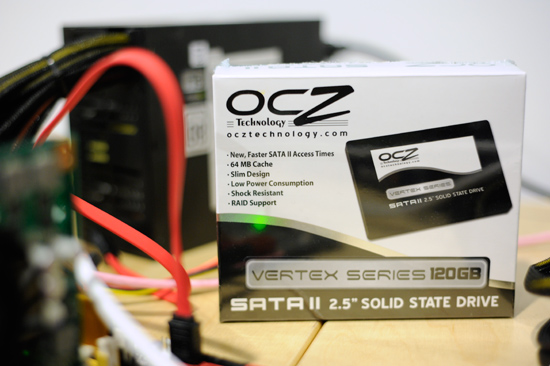
The drive itself looked identical to the first Vertex I tested, but the differences were all internal. The new drive used a new PCB layout, let’s pop the top off to see it:

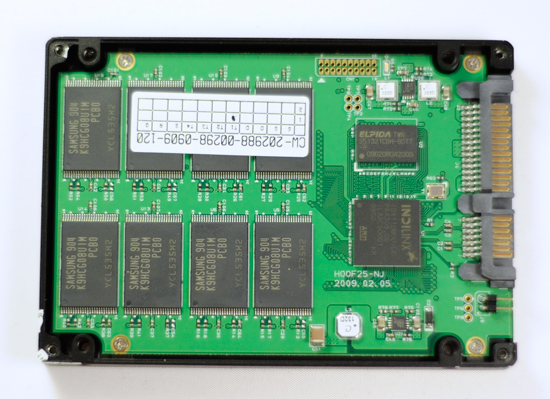
Oooh.
The major change on the new board layout is the addition of a 2-pin jumper on the back of the drive to allow the drive’s firmware to be updated by the end user. OCZ tells me that as of 1275, the jumper is no longer needed to update the firmware so it looks like it was a short lived change.
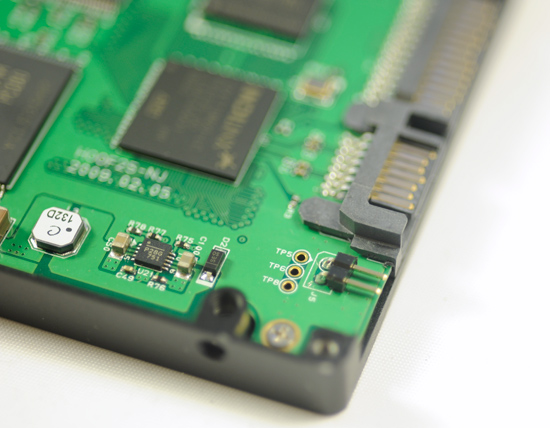
While OCZ claims that there’s significant validation done on each firmware revision, without a doubt it’s significantly less than what every Intel and Samsung drive goes through. There’s a certain amount of risk you take when jumping on the unproven hardware bandwagon, so as always proceed with caution. It’s worth looking into
While I haven’t done much testing on 1275, I can’t blame you if you want to try the firmware out right away because it is good.
I’ll start with the best news first. I looked at 4KB random write performance once again using iometer. This test is the same one I used in last week’s review; a 3 minute run, 3 outstanding IOs, 4KB random writes spread out over an 8GB section of LBAs. I filled the drive completely before running the test.
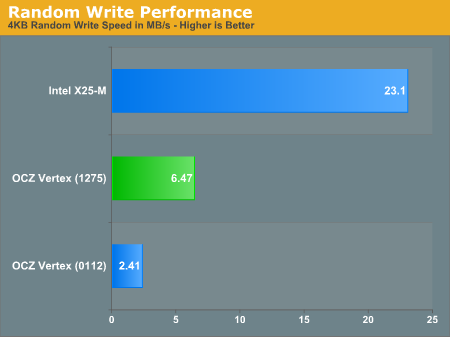
| Random Write (4KB Block, 3 IOs) | IOPS | Transfer Rate | Average Latency (ms) |
| Intel X25-M | 5923 | 23.1 MB/s | 0.51 ms |
| OCZ Vertex 1275 | 1656 | 6.47 MB/s | 1.81 ms |
| OCZ Vertex 0112 | 617 | 2.41 MB/s | 4.86 ms |
Yeah. It’s fast. Not quite as fast as Intel’s X25-M but it’s good. Average latency has dropped quite a bit. The Vertex using firmware 1275 performs used at about the level that the original firmware performed brand new. The Intel drive can still crunch through over 3.5x the number of IOs per second as the Vertex, but it also costs nearly 2x per GB. The Vertex proves itself an interesting value alternative.
I then looked at random read performance. Now most SSDs do just fine here, even the JMicron based ones.
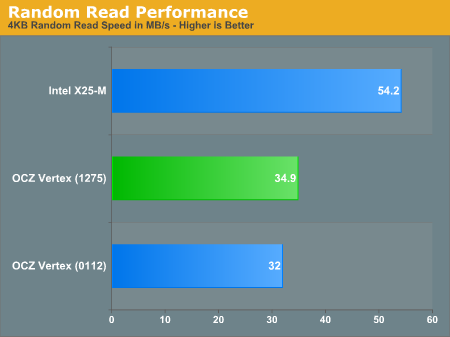
| Random Read (4KB Block, 3 IOs) | IOPS | Transfer Rate | Average Latency (ms) |
| Intel X25-M | 13883 | 54.2 MB/s | 0.22 ms |
| OCZ Vertex 1275 | 8931 | 34.9 MB/s | 0.34 ms |
| OCZ Vertex 0112 | 8184 | 32.0 MB/s | 0.37 ms |
The new firmware bumped up the Vertex’s performance by about 9%.
I spoke briefly with one of OCZ’s flash engineers and it seems like the reason the 1275 firmware is so much faster in random write speed is because of a bug in the 0112 firmware I tested with. There was apparently a problem with the 0112 firmware that prevented the controller from writing to as many flash devices as possible in parallel. The 1199 firmware fixed this, which explains why the sudden rush to ship the firmware. Unfortunately it looks like that version also has problems and thus we end up back at square one again. There’s no free lunch folks.
Sequential read performance showed a very marginal performance improvement:
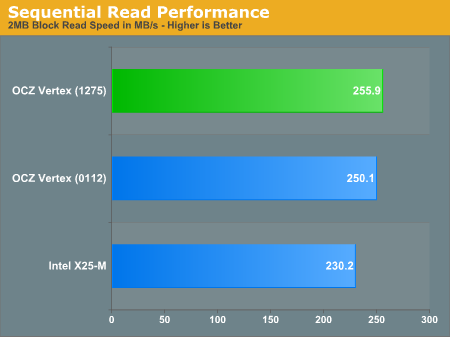
| Sequential Read (2MB Block, 1 IO) | IOPS | Transfer Rate | Average Latency (ms) |
| Intel X25-M | 115.1 | 230.2 MB/s | 8.7 ms |
| OCZ Vertex 1275 | 127.9 | 255.9 MB/s | 7.8 ms |
| OCZ Vertex 0112 | 125.1 | 250.1 MB/s | 8.0 ms |
But sequential write performance went up tremendously:
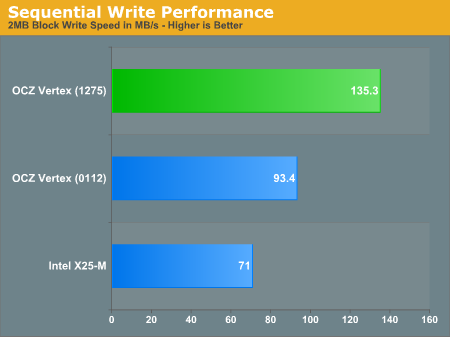
| Sequential Write (2MB Block, 1 IO) | IOPS | Transfer Rate | Average Latency (ms) |
| Intel X25-M | 35.5 | 71 MB/s | 28.2 ms |
| OCZ Vertex 1275 | 67.7 | 135.3 MB/s | 14.8 ms |
| OCZ Vertex 0112 | 46.7 | 93.4 MB/s | 21.4 ms |
The Indilinx (and most other) drives offer better sequential read/write speed than the X25-M. Intel optimized for the most important characteristics for a desktop: random read/write performance, while most other manufacturers optimized for sequential read/write. Indilinx is the first to seem to want to really drive sequential without completely forgetting about random performance.










73 Comments
View All Comments
landheha - Saturday, July 18, 2009 - link
The risk I see in all this is putting a windows page file on such a drive that is actually used. Or an Oracle rollback tablespace or redo logfiles. These will get this kind of drive into "used-status" in no time. Not to speak of the 10.000x erase limit.As another guy said before, the difference between SLC and MLC is not to be neglected.
anactoraaron - Thursday, June 25, 2009 - link
Something I have noticed under win 7 RC x64 on my laptop is that when running on battery only the system boots up and shuts down faster than when on ac alone. I don't know why yet and this is especially revelant as even with the slightly lesser ssd's - basically non-intel - can improve laptop performance/responsiveness twofold vs. 7200rpm platter hdd's (as shown in the intial x25-m review). As far as the running on battery variable is concerned, my average shut down time on ac power is 17 seconds, and on battery it is 10 seconds (or less). Is there maybe something else going on in windows 7 that is an unknown as of now?Yes, after enjoying the initial review of the X25-M I had to spend about an hour to see where my platter hdd stood (and I'm sure I'm not the only one here that did so).
vhx - Saturday, June 13, 2009 - link
Intel X25-M or OCZ Vertex 120?The Intel seems to own it at almost everything except a few writing cases. However the theoretical 180 MB/s Write doesn't seem to show up in anything but synthetic benchmarks which STILL makes it even with the X25-M in real world performance. Not to mention the Vertex's seem to still have major performance degradations compared to X25-M's loss.
What would you all get if you had a choice?
Patanjali - Monday, May 4, 2009 - link
These seem to have a reasonable write io ops/s compared to any of those that cost less than the Intel, and they are coming cheaper all the time. They use a 2nd generation Samsung controller.When will Anandtech review them and forget about all these experiments?
Gootch - Sunday, April 19, 2009 - link
As always, my comments to your previous article should have waited until I had read the latest on these drives. However, X25 is the best (for now) and in some cases arguably cheaper/Gb. Once again a great article follow-up.steffi - Thursday, April 16, 2009 - link
So I managed to use a collegue's Intel PC at work to update the firmware in my X-25M but I've got a couple of questions ...1. Did that firmware resolve the NVidia compatibiity such that in the future I can apply the firmware update from my MacBook Pro Unibody NVidia machine?
2. Did this firmware resolve the Bootcamp issue?
3. How is it possible to use issue the SECURE_ERASE on a Mac then since it doesn't appear that HDDERASE will work given the need for legacy IDE mode?
SpeedDemonAaron - Monday, April 13, 2009 - link
Thank you so much for your honest and concise articles on SSDs lately! This is the most important hardware change that the tech world has seen in a long time. There are a lot of bits that need to be uncovered so that the public knows what they are getting themselves into. You're doing an outstanding job of protecting the consumer since manufacturers are definitely producing SSD products at the moment with no regard for the consumer!mmoran27 - Monday, April 13, 2009 - link
Here it is.Must be done on Intel system or PC
http://support.intel.com/support/ssdc/index_update...">http://support.intel.com/support/ssdc/index_update...
MadBoris - Monday, April 13, 2009 - link
PcPer did some test on the new Intel Firmware for the x25-M.Fragmentation issue went away but the drive is still to expensive. ;)
http://pcper.com/article.php?aid=691&type=expe...">http://pcper.com/article.php?aid=691&type=expe...
Eri Hyva - Saturday, April 11, 2009 - link
http://www.ocztechnology.com/products/flash_drives...">http://www.ocztechnology.com/products/f...ives/ocz...
The change log for firmware:
"
Version 0112 (Feb. 2009) (Description: Basic I/O optimized drive with SMART error logging)
• Version 1199 (Feb. 2009) (Description: Enhanced performance I/O optimized drive)
• Internal "write join" was implemented for better performance
•SMART basic features can be performed without error log monitoring
(to reduce overhead of log data collection)
•ATA power management commands (IDLE, STANDBY, SLEEP) are enabled for compatibility
(Actually these are dummy, while SATA based Power Management is fully supported)
• Supports runtime bad block handling
•Improved power management
•Improved NAND handling
•Enabled PIO mode data transfer
• Version 1275 (March, 2009) (Description: Improved raid 0 mode performance)
•Performance is improved when drive is installed on RAID0 mode host
•Maximum LBA number is modified according to the JEDEC standard
• Modifications of internal data structure used by FW (stamp)
•Improved write joining
•Improved FPDMA transfer mode
• Version 1.10 (April 7, 2009)
•Feature Add : TRIM support is added
•Apple Mac Pro sleep/wake up support added
• Updater improved
•Bad block management function improved
"